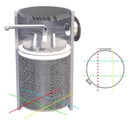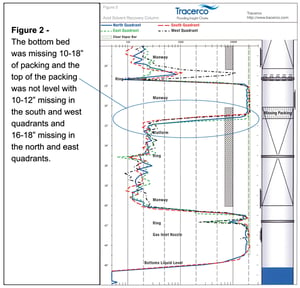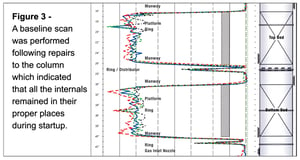Tru-Grid™ Scans reveal vital process information that helps solve operating problems.
A Tru-Grid™ Scan of packed towers is a reliable and widely used field measurement used for evaluating the hydraulic performance in packed

beds, including the results from plugging / fouling or damage. When experiencing problems there are two important questions you would like answered:
1. Where is the fouling / plugging or damage?
2. What is the extent of the hydraulic problem due to fouling or damage to the packing?
Gamma scanning has proven to be an essential measurement tool to supplement operating history data analysis. Process engineers and operations personnel need to know what is happening inside their process equipment so they can take corrective action. A Tru-Grid™ Scan provides a density profile of the internal process to diagnose hydraulic operating conditions such as damage to internals, flooding, liquid levels on trays and distributors, and liquid distribution through packed beds.
Performing Tru-Grid™ Scans before a scheduled shutdown can help capture real-time data to optimize your turnaround and reduce cost over-runs. Scan results will prepare those planning the turnaround activities with the knowledge needed for critical path decisions. Scans performed five to six weeks prior to a scheduled shutdown usually provides enough time to order new equipment without expediting charges and to schedule the required manpower.
In this latest blog, Tracerco, part of Johnson Matthey Plc, discusses how an unexpected pressure surge affected the performance of an acid solvent recovery column.
Project Field Test
One of the more unfortunate events that process plant operators and support staff face is an unexpected pressure surge. Whether the surge

affects an entire plant, a unit or a single piece of equipment, assessing the physical condition afterwards can be a challenge.
Recently a customer contacted Tracerco regarding an acid solvent recovery column. Since a pressure surge the column had been experiencing poor recovery efficiency. Plant personnel suspected damage caused from the pressure surge and they needed to confirm it’s extent or find what other problems may exist. This particular column was packed with two beds of random ceramic saddles. During upsets or pressure swings this type of ceramic can dislocate, compressing and crushing some of the packing. Alternatively liquid distributors, bed supports, and other internals can be dislocated or damaged preventing them from performing as they should.
A Tracerco Tru-Grid™ Scan was performed to verify that the beds and distributors were in place and to identify any problem before entering the column.
Project Analysis
Based on the scan results (Figure 1) the top liquid distributor was shown to be holding approximately 24” of dense material and was operating in a flooded condition and/or had packing resting on the distributor tray.
The top portion of the upper bed appeared to be missing 30” of packing which could be due to lack of packing elements installed or displaced packing that was blown up onto the top liquid distributor. This bed was also operating with poor liquid distribution with liquid channeling through the south quadrant and liquid deficiency through the east quadrant.
The space between the bottom of the top bed and the liquid distributor above the lower bed should have shown a clear vapor space if all was well with the column. Instead this space was very dense with either liquid and/or packing material, especially in the eastern quadrant of the column. This could indicate a breach in the eastern portion of the top bed support that would have caused packing to collapse onto the distributor.

The top portion of the bottom bed appeared to have 10-18” of packing missing and the top of the packing was uneven with 10-12” missing in the south and west quadrants and 16-18” missing in the north and east quadrants (Figure 2). This missing material could indicate displaced packing that could have been blown up onto the bottom liquid distributor. The bed was also operating with a slight density gradient with denser material in the lower portion compared to the top indicating crushed or settled packing or fouling in the lower portion of the bed. The liquid distribution through this bed was fair-to-good in the top half but was worse in the bottom half of the bed.
After reviewing the scan results the customer entered the column a few weeks after the scan to make repairs. They found that the top bed hold
down plate was missing so packing from the top bed had been carried up onto the top liquid distributor. This caused the top distributor to appear flooded. The top hold down grid for the top bed was found buried in the lower portion of the packing. The bottom support grid for the top bed was still in place so no packing from the top bed had collapsed onto the bottom liquid distributor.
Like the top bed, the hold down plate for the bottom bed was not in place so packing had carried up from the bottom bed onto the bottom liquid distributor. This accounted for the high density in the vapor space between the top bed and the bottom liquid distributor instead of a top bed collapse. The hold down grid for the bottom bed was buried in an almost vertical position in the lower portion of the packing.
After all repairs were complete and the column restarted, the customer requested a baseline scan. The baseline scan results can be viewed in

Figure 3. The baseline scan indicated that all internals remained in their proper places during startup and both beds were operating with fairly good liquid distribution. The baseline information will provide invaluable reference data for future troubleshooting scans.
Conclusion
The application of a Tracerco Tru-Grid™ Scan allowed confirmation to the customer that significant packed bed displacement had occurred and pinpointed those areas of most concern. This allowed the customer to verify that a shutdown was necessary, understand the areas within the column of most concern and prepare equipment and field services for the necessary repairs in advance minimizing downtime at the site.
Click here for a printable version of the case study.
If you want to learn more about how Tracerco's PackView™ technology please complete the form on our contact us page at http://www.tracerco.com/contact-us and request additional PackView™ case studies.
 beds, including the results from plugging / fouling or damage. When experiencing problems there are two important questions you would like answered:
beds, including the results from plugging / fouling or damage. When experiencing problems there are two important questions you would like answered: affects an entire plant, a unit or a single piece of equipment, assessing the physical condition afterwards can be a challenge.
affects an entire plant, a unit or a single piece of equipment, assessing the physical condition afterwards can be a challenge.
 Figure 3. The baseline scan indicated that all internals remained in their proper places during startup and both beds were operating with fairly good liquid distribution. The baseline information will provide invaluable reference data for future troubleshooting scans.
Figure 3. The baseline scan indicated that all internals remained in their proper places during startup and both beds were operating with fairly good liquid distribution. The baseline information will provide invaluable reference data for future troubleshooting scans.